Jonathan Li
Cautious Weight Decay
Oct 14, 2025Abstract:We introduce Cautious Weight Decay (CWD), a one-line, optimizer-agnostic modification that applies weight decay only to parameter coordinates whose signs align with the optimizer update. Unlike standard decoupled decay, which implicitly optimizes a regularized or constrained objective, CWD preserves the original loss and admits a bilevel interpretation: it induces sliding-mode behavior upon reaching the stationary manifold, allowing it to search for locally Pareto-optimal stationary points of the unmodified objective. In practice, CWD is a drop-in change for optimizers such as AdamW, Lion, and Muon, requiring no new hyperparameters or additional tuning. For language model pre-training and ImageNet classification, CWD consistently improves final loss and accuracy at million- to billion-parameter scales.
TDRM: Smooth Reward Models with Temporal Difference for LLM RL and Inference
Sep 18, 2025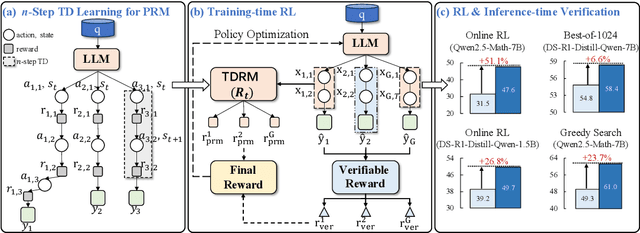

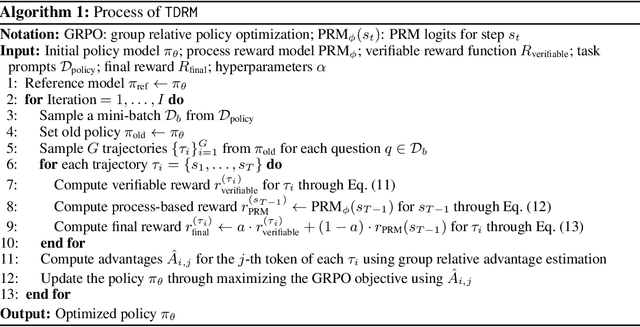

Abstract:Reward models are central to both reinforcement learning (RL) with language models and inference-time verification. However, existing reward models often lack temporal consistency, leading to ineffective policy updates and unstable RL training. We introduce TDRM, a method for learning smoother and more reliable reward models by minimizing temporal differences during training. This temporal-difference (TD) regularization produces smooth rewards and improves alignment with long-term objectives. Incorporating TDRM into the actor-critic style online RL loop yields consistent empirical gains. It is worth noting that TDRM is a supplement to verifiable reward methods, and both can be used in series. Experiments show that TD-trained process reward models (PRMs) improve performance across Best-of-N (up to 6.6%) and tree-search (up to 23.7%) settings. When combined with Reinforcement Learning with Verifiable Rewards (RLVR), TD-trained PRMs lead to more data-efficient RL -- achieving comparable performance with just 2.5k data to what baseline methods require 50.1k data to attain -- and yield higher-quality language model policies on 8 model variants (5 series), e.g., Qwen2.5-(0.5B, 1,5B), GLM4-9B-0414, GLM-Z1-9B-0414, Qwen2.5-Math-(1.5B, 7B), and DeepSeek-R1-Distill-Qwen-(1.5B, 7B). We release all code at https://github.com/THUDM/TDRM.
Maps for Autonomous Driving: Full-process Survey and Frontiers
Sep 16, 2025Abstract:Maps have always been an essential component of autonomous driving. With the advancement of autonomous driving technology, both the representation and production process of maps have evolved substantially. The article categorizes the evolution of maps into three stages: High-Definition (HD) maps, Lightweight (Lite) maps, and Implicit maps. For each stage, we provide a comprehensive review of the map production workflow, with highlighting technical challenges involved and summarizing relevant solutions proposed by the academic community. Furthermore, we discuss cutting-edge research advances in map representations and explore how these innovations can be integrated into end-to-end autonomous driving frameworks.
SAGOnline: Segment Any Gaussians Online
Aug 11, 2025Abstract:3D Gaussian Splatting (3DGS) has emerged as a powerful paradigm for explicit 3D scene representation, yet achieving efficient and consistent 3D segmentation remains challenging. Current methods suffer from prohibitive computational costs, limited 3D spatial reasoning, and an inability to track multiple objects simultaneously. We present Segment Any Gaussians Online (SAGOnline), a lightweight and zero-shot framework for real-time 3D segmentation in Gaussian scenes that addresses these limitations through two key innovations: (1) a decoupled strategy that integrates video foundation models (e.g., SAM2) for view-consistent 2D mask propagation across synthesized views; and (2) a GPU-accelerated 3D mask generation and Gaussian-level instance labeling algorithm that assigns unique identifiers to 3D primitives, enabling lossless multi-object tracking and segmentation across views. SAGOnline achieves state-of-the-art performance on NVOS (92.7% mIoU) and Spin-NeRF (95.2% mIoU) benchmarks, outperforming Feature3DGS, OmniSeg3D-gs, and SA3D by 15--1500 times in inference speed (27 ms/frame). Qualitative results demonstrate robust multi-object segmentation and tracking in complex scenes. Our contributions include: (i) a lightweight and zero-shot framework for 3D segmentation in Gaussian scenes, (ii) explicit labeling of Gaussian primitives enabling simultaneous segmentation and tracking, and (iii) the effective adaptation of 2D video foundation models to the 3D domain. This work allows real-time rendering and 3D scene understanding, paving the way for practical AR/VR and robotic applications.
PointGauss: Point Cloud-Guided Multi-Object Segmentation for Gaussian Splatting
Aug 01, 2025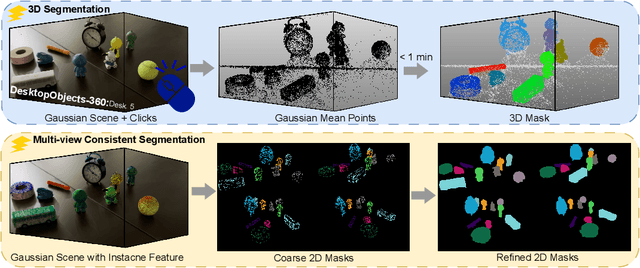



Abstract:We introduce PointGauss, a novel point cloud-guided framework for real-time multi-object segmentation in Gaussian Splatting representations. Unlike existing methods that suffer from prolonged initialization and limited multi-view consistency, our approach achieves efficient 3D segmentation by directly parsing Gaussian primitives through a point cloud segmentation-driven pipeline. The key innovation lies in two aspects: (1) a point cloud-based Gaussian primitive decoder that generates 3D instance masks within 1 minute, and (2) a GPU-accelerated 2D mask rendering system that ensures multi-view consistency. Extensive experiments demonstrate significant improvements over previous state-of-the-art methods, achieving performance gains of 1.89 to 31.78% in multi-view mIoU, while maintaining superior computational efficiency. To address the limitations of current benchmarks (single-object focus, inconsistent 3D evaluation, small scale, and partial coverage), we present DesktopObjects-360, a novel comprehensive dataset for 3D segmentation in radiance fields, featuring: (1) complex multi-object scenes, (2) globally consistent 2D annotations, (3) large-scale training data (over 27 thousand 2D masks), (4) full 360{\deg} coverage, and (5) 3D evaluation masks.
Muon Optimizes Under Spectral Norm Constraints
Jun 18, 2025Abstract:The pursuit of faster optimization algorithms remains an active and important research direction in deep learning. Recently, the Muon optimizer [JJB+24] has demonstrated promising empirical performance, but its theoretical foundation remains less understood. In this paper, we bridge this gap and provide a theoretical analysis of Muon by placing it within the Lion-$\mathcal{K}$ family of optimizers [CLLL24]. Specifically, we show that Muon corresponds to Lion-$\mathcal{K}$ when equipped with the nuclear norm, and we leverage the theoretical results of Lion-$\mathcal{K}$ to establish that Muon (with decoupled weight decay) implicitly solves an optimization problem that enforces a constraint on the spectral norm of weight matrices. This perspective not only demystifies the implicit regularization effects of Muon but also leads to natural generalizations through varying the choice of convex map $\mathcal{K}$, allowing for the exploration of a broader class of implicitly regularized and constrained optimization algorithms.
Synthetic Document Question Answering in Hungarian
May 29, 2025Abstract:Modern VLMs have achieved near-saturation accuracy in English document visual question-answering (VQA). However, this task remains challenging in lower resource languages due to a dearth of suitable training and evaluation data. In this paper we present scalable methods for curating such datasets by focusing on Hungarian, approximately the 17th highest resource language on the internet. Specifically, we present HuDocVQA and HuDocVQA-manual, document VQA datasets that modern VLMs significantly underperform on compared to English DocVQA. HuDocVQA-manual is a small manually curated dataset based on Hungarian documents from Common Crawl, while HuDocVQA is a larger synthetically generated VQA data set from the same source. We apply multiple rounds of quality filtering and deduplication to HuDocVQA in order to match human-level quality in this dataset. We also present HuCCPDF, a dataset of 117k pages from Hungarian Common Crawl PDFs along with their transcriptions, which can be used for training a model for Hungarian OCR. To validate the quality of our datasets, we show how finetuning on a mixture of these datasets can improve accuracy on HuDocVQA for Llama 3.2 11B Instruct by +7.2%. Our datasets and code will be released to the public to foster further research in multilingual DocVQA.
Command A: An Enterprise-Ready Large Language Model
Apr 01, 2025



Abstract:In this report we describe the development of Command A, a powerful large language model purpose-built to excel at real-world enterprise use cases. Command A is an agent-optimised and multilingual-capable model, with support for 23 languages of global business, and a novel hybrid architecture balancing efficiency with top of the range performance. It offers best-in-class Retrieval Augmented Generation (RAG) capabilities with grounding and tool use to automate sophisticated business processes. These abilities are achieved through a decentralised training approach, including self-refinement algorithms and model merging techniques. We also include results for Command R7B which shares capability and architectural similarities to Command A. Weights for both models have been released for research purposes. This technical report details our original training pipeline and presents an extensive evaluation of our models across a suite of enterprise-relevant tasks and public benchmarks, demonstrating excellent performance and efficiency.
LLMs Know What to Drop: Self-Attention Guided KV Cache Eviction for Efficient Long-Context Inference
Mar 11, 2025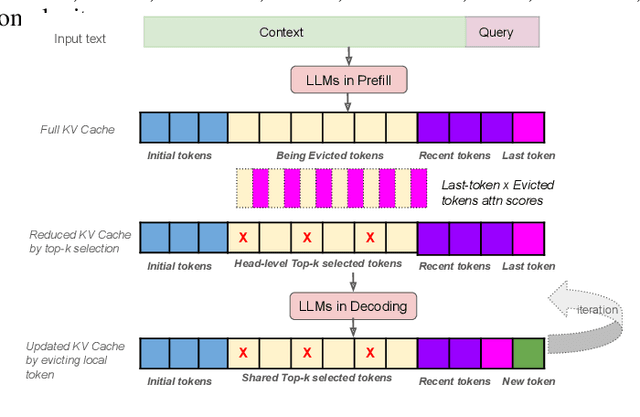
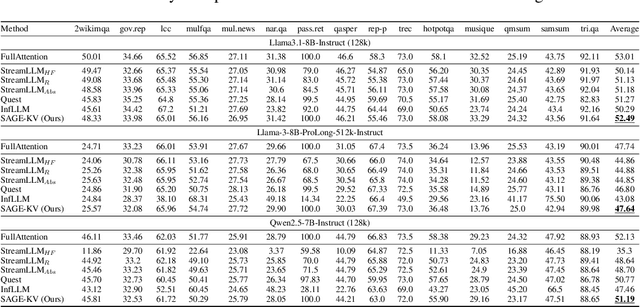
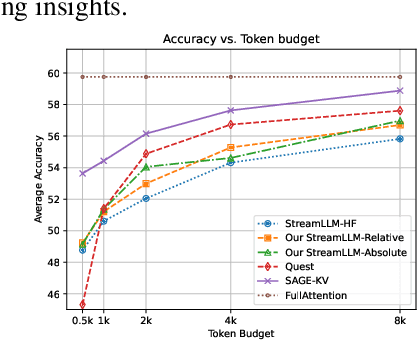

Abstract:Efficient long-context inference is critical as large language models (LLMs) adopt context windows of ranging from 128K to 1M tokens. However, the growing key-value (KV) cache and the high computational complexity of attention create significant bottlenecks in memory usage and latency. In this paper, we find that attention in diverse long-context tasks exhibits sparsity, and LLMs implicitly "know" which tokens can be dropped or evicted at the head level after the pre-filling stage. Based on this insight, we propose Self-Attention Guided Eviction~(SAGE-KV), a simple and effective KV eviction cache method for long-context inference. After prefilling, our method performs a one-time top-k selection at both the token and head levels to compress the KV cache, enabling efficient inference with the reduced cache. Evaluations on LongBench and three long-context LLMs (Llama3.1-8B-Instruct-128k, Llama3-8B-Prolong-512k-Instruct, and Qwen2.5-7B-Instruct-128k) show that SAGE-KV maintains accuracy comparable to full attention while significantly improving efficiency. Specifically, SAGE-KV achieves 4x higher memory efficiency with improved accuracy over the static KV cache selection method StreamLLM, and 2x higher memory efficiency with better accuracy than the dynamic KV cache selection method Quest.
Digital Twin Buildings: 3D Modeling, GIS Integration, and Visual Descriptions Using Gaussian Splatting, ChatGPT/Deepseek, and Google Maps Platforms
Feb 09, 2025Abstract:Urban digital twins are virtual replicas of cities that use multi-source data and data analytics to optimize urban planning, infrastructure management, and decision-making. Towards this, we propose a framework focused on the single-building scale. By connecting to cloud mapping platforms such as Google Map Platforms APIs, by leveraging state-of-the-art multi-agent Large Language Models data analysis using ChatGPT(4o) and Deepseek-V3/R1, and by using our Gaussian Splatting-based mesh extraction pipeline, our Digital Twin Buildings framework can retrieve a building's 3D model, visual descriptions, and achieve cloud-based mapping integration with large language model-based data analytics using a building's address, postal code, or geographic coordinates.
 Add to Chrome
Add to Chrome Add to Firefox
Add to Firefox Add to Edge
Add to Edge